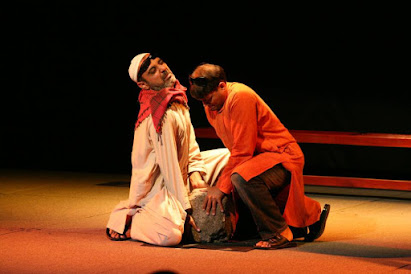THEATRE CULTURE OF PAKISTAN
THEATRE CULTURE OF PAKISTAN
Written By: Aamir Nawaz
Throughout history, theater has both entertained and educated. The range of theatrical genres—comedy, drama, opera, musical theater, and more—have been mediums for audiences and artists to bring new experiences and understandings to their worlds. Along with dance, theater has sometimes been disapproved by the government of Pakistan and has rarely been given economic support. Regardless, it has continued to thrive in the culture.
In the early years after independence, the urban theater was
limited to dramas in colleges and universities and occasional visiting troupes,
performing mostly Shakespeare’s plays, which later led to original adaptations.
Inspired by the oratory tradition of poetry in the Moghul courts and the
growing radio medium, a style of performance grounded in the musicality of the
spoken word continued in new forums like The Arts Council in Lahore—set up by
radio celebrities like Imtiaz Ali Taj and Rafi Peer. In Karachi, Khwaja
Moenuddin wrote a number of original satires, which are still performed today.
Folk theater (tamasha, swaang and nautaunki)
and surviving folk genres, including storytelling (dastaan-goh) and
puppetry, continued outside the cities. In South Asia, as throughout the world,
traditionally most public performers have been men. In Pakistan some of the
most famous theater celebrities have been women, like Bali Jatti, who ran her
own theater company and was loved by audiences.
Storytelling (Dastaan-goh)
Storytelling, usually
interspersed with singing and instrumental accompaniment, is an ancient art
that is endangered in modern Pakistan. Cultural conservation efforts are
focused on reviving the art of traditional storytelling by recording
storytellers spinning their tales, as well as encouraging young people to learn
the rhythms, methods, and expressions of old storytellers.
One place where this
effort is at work is in the city of Peshawar, the capital of the Province of
Pakistan. Because of its location on the land routes linking Central Asia with
India, the Far East and the West, Peshawar was a hub of commerce and art, as
people came through the city on their way across the continents.
In ancient times, what
is now the old section of the city was home to the qissakhwāni bāzār, "the
bazaar of storytellers," where people from many cultures and traditions
would gather to hear and exchange stories, creating a vibrant ‘marketplace’ for
folktales, local parables, and stories with universal themes. Over time, the
old part of the city still retained some of its reputation as the place for
cultural connections, but as late as 1977, a search for professional
storytellers in the city found only a handful of the traditional stories and
storytellers.
Despite this, the oral tradition of storytelling continues in the popular theater, which can be found in all of the major cities of Pakistan. Inspired by folk genres like bhaands (clowning), actors improvise without a script and outwit each other with verbal punning and physical comedy. These plays have a huge following and are reproduced on cable television channels and sold in video stores.
Puppetry
String, hand, and rod
puppets are all favorites in festivals and small traveling shows around
Pakistan. Puppets are just as often made of modern materials like foam as they
are wood, leather, and other traditional materials.
The oldest form of
puppetry in Pakistan is the putli, or string puppet, which is
performed by wandering puppeteers who create a makeshift stage in villages with
propped up beds. The puppeteer has a reed whistle between his teeth to make
chirping sounds for the puppets while he manipulates the string puppets with
both hands. His wife sings songs to the accompaniment of a small double-headed
drum (dholak). This puppet theater features the emperor and courtiers of
the imperial Mughal court.
Protest Theater
Since the 1980s,
artists have used the form of alternative, or Protest Theater to examine
contemporary issues and encourage social change. Many playwrights, directors,
and actors—including many women—have used theater to hold a mirror up to
society, presenting taboo-breaking works on stages and in other settings,
including rural villages, city streets, and in schools. Ashfaq Ahmad, who
died in 2004, was a playwright who often highlighted thought-provoking issues
in his plays and stories, using humor and satire to touch on the social and
political concerns of the first Pakistani generation to grow up after
Partition. Another contemporary author, Shahid Nadeem—the in-house playwright
for Lahore’s Ajoka Theater —has written plays that directly confronted some of
Pakistan’s important social issues. Other protest theater groups which still
operate today are Karachi-based Tehrik-e-Niswan and Lahore’s Lok Rehas &
Maas Foundation.










🥰🥰আমার জন্যে বাংলা হলে সুবিধে।কিন্তু লেখাটা আর একটু ডিটেল হলে ভালো হত।লেখককে ধন্যবাদ।
ReplyDeleteআপনাকে ধন্যবাদ।
ReplyDelete